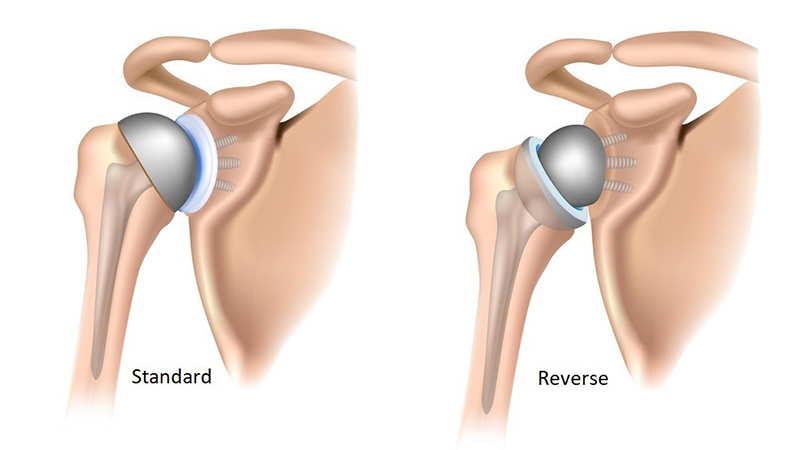What You Need to Know About Total Shoulder Replacement
Options for Arthritis or Severe Rotator Cuff Tears
Published February 2024
Your shoulders are the most flexible and complex joints in your body — which means they’re also prone to injury.
There are many ways you can injure your shoulders, including fracture, sprain and dislocation. Most injuries can be treated with non-invasive methods like physical therapy and rest, but there are two common reasons why you may need a total shoulder replacement surgery:
Cortisone injections only provide temporary relief.— Tony J. Choi, MD
- Arthritis. Your joints are lined with cartilage, a connective tissue that protects your bones. If the cartilage of your shoulder wears down due to injury, age or an underlying autoimmune disease such as rheumatoid arthritis, the loss of cartilage can cause pain and reduced shoulder mobility. “I often tell my patients that arthritis makes your shoulder joint feel like a rusted out ball bearing,” says Tony J. Choi, MD, a shoulder and elbow surgeon at Northwestern Medicine. “It squeaks, it grinds, and it causes pain. The biggest issue patients face is that they don’t have mobility like they used to.”
- A torn rotator cuff that can’t be repaired with standard rotator cuff surgery. Your rotator cuff is a group of muscles and tendons that allows you to move your shoulder. The standard surgery for a torn rotator cuff involves reattaching your rotator cuff tendon back to your upper arm bone. For severe rotator cuff injuries, this is not an option. In these cases, a special kind of total shoulder replacement called reverse shoulder replacement can relieve pain and restore function.
Types of Total Shoulder Replacement Surgery
Your shoulder joint is a “ball-in-socket” joint. The top of your humerus (upper arm bone) is rounded and sits in a socket called the glenohumeral joint.

Standard Total Shoulder Replacement
In a standard total replacement surgery, orthopaedic surgeons remove the head of the humerus. Then, they replace it with a prosthetic. They also replace the cup of the glenohumeral joint with a prosthetic.
Reverse Total Shoulder Replacement Surgery
In a reverse total shoulder replacement surgery, used for severed rotator cuff injuries or in cases where the shoulder joint is severely deteriorated, surgeons flip your shoulder anatomy.
They screw a prosthetic ball into the glenohumeral socket joint and connect it to a prosthetic stem where the head of your humerus used to be. After surgery, your shoulder will function like normal, but you’ll use a different muscle to raise your arm overhead than you did before surgery.
Advances in Total Shoulder Replacement Surgery
Dr. Choi has been doing shoulder replacement surgeries for more than 15 years, and he says that the outcomes for both standard shoulder replacement surgery and reverse total shoulder replacement surgery are typically very good. Both can be done in the hospital, but more often, the procedures are being done outpatient, meaning most patients can go home on the day of their surgery.
Dr. Choi also says that pain is often very minimal after shoulder replacement surgery. Most people experience mild pain where they had surgery, which they can manage with over-the-counter medications like ibuprofen or acetaminophen. Dr. Choi says that the accelerated recovery program at Northwestern Medicine can help reduce pain during recovery. He also attributes the often-minimal pain to the fact that many of the total shoulder prosthetics do not need a rod inserted down the humerus to place the ball joint.
Dr. Choi is also doing GPS-navigated shoulder replacement surgery, where he uses a CT scan and places computer tracking devices during surgery to help precisely position the prosthetic parts. This is typically done when a patient has significant shoulder deformity.
Deciding to Get a Total Shoulder Replacement
While there are non-surgical options for treating shoulder pain, such as cortisone, gel and biologic injections, the decision to get a total shoulder replacement is entirely up to you.
Recovery from total shoulder replacement takes about two to six months and often involves physical therapy.
It is also important to undergo a shoulder replacement with a surgeon who has advanced training in shoulder replacement surgery — a fellowship-trained shoulder and elbow surgeon — or a surgeon who performs a high volume of shoulder replacements and has a proven track record of success.
“A lot of my patients will reach a point where their shoulder pain and mobility are interfering with their life and they can’t do the things they want to do,” says Dr. Choi. “Cortisone injections only provide temporary relief, so I tell my patients that if they’re not able to enjoy life due to their shoulder, then we should have a more in-depth discussion about shoulder replacement surgery.”






